Colourful MexicoCreated in an internet cafe in Guadalahara, Mexico, in March 2004Mexico is colourful - very colourful. When we admired the houses in La Paz, our last stop of Baja California (see collage in our previous report), we had no idea that things would become even more colourful later. |
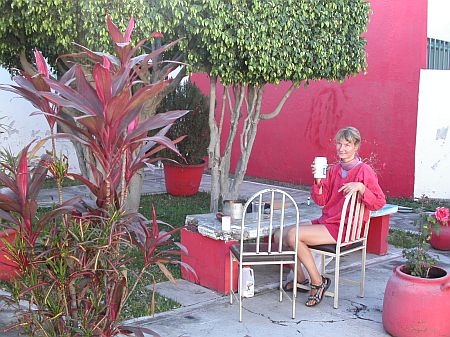 The patients are on leave: Markus and Mila at the Red Cross in Tepic. For the first time on our tour of the world we were struck hard: We had caught a heavy influenza in La Paz. By chance we were just near the Red Cross in Tepic. This is the great kind of lucky coincidence that happens to you on a journey. We received treatment, a prescription and accomodation in the hospital - all for free. To make meals on our camping cooker we went to the little inner courtyard, which was decorated in the corporate colours, red and white. Our heartfelt thanks to the Red Cross team (also see our "who we met" page)! (mi) |
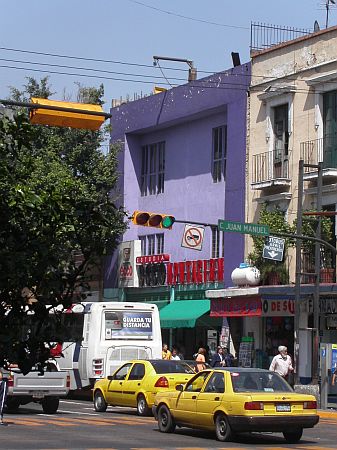 By taking a bus we were able to avoid a large portion of the cyclist's nightmare of a route between the coast and Guadalajara. In doing so we followed advice from cyclist's guides and from other travelers by bike. However, this did not help us escape the traffic in the city of Guadalajara. You may get used to the turmoil on streets with four to six lanes, but never to the diesel smoke from the numerous busses racing against the yellow cabs. Only after we had begun using buses ourselves we were able to enjoy the joyfully coloured streets of Guadalajara. (mi) |
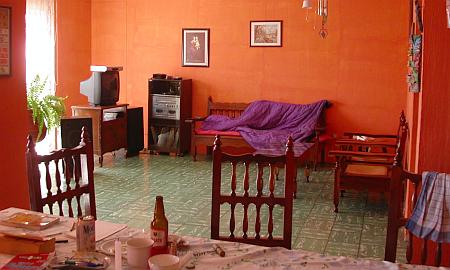 After Heber's green hair salon in La Paz and the red courtyard at the Red Cross in Tepic our next place to stay was all in orange. This is the living-room of a shared apartment, in which we lived for ten days (see also on the "Who we met" page). We talked a lot in German with the others in the apartment, and the fact that we had a room in an apartment "of our own" made Markus feel so much at home that one morning he woke up and asked, quite confused, wether we had already come back to Germany. (mi) |
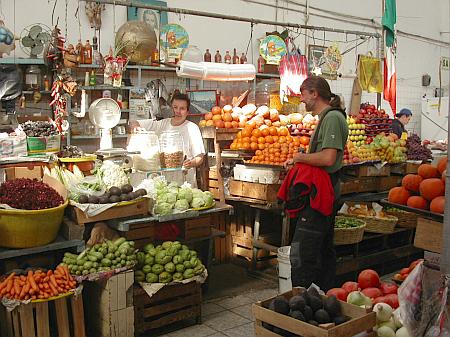 The markets of Guadalajara, especially Mercado Libertad, in Mexico's largest market hall, cast a particular spell on us. We spent hours after hours strolling the narrow lanes between the colourful market stalls and gazing at everything offered there. It was a feast for the senses, with so many impressions that we could hardly deal with on our first visit. Thats why we went there four times altogether. (mi) |
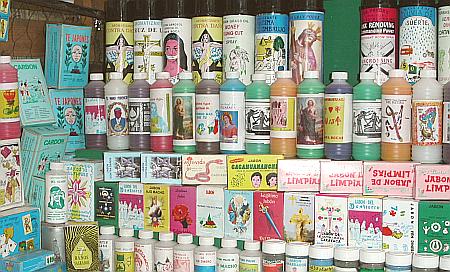 At Mercado Libertad you can get simply everything. Clothes, hats, shoes, food, pets, furniture, electric appliances, tools, saddles, souvernirs, jewellery... And in fact, we by far haven't seen it all. The many little medicines, all sold in ugly, badly designed packages, struck us as quite odd. But among the Mexicans, there seems to be high demand on such wonder cures. That's the only explanation we have for the extensive supply. Or maybe there's just one rule: "the main thing is: it's colourful!" (mi) |
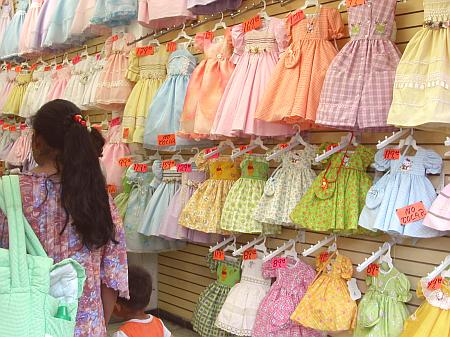 We have strolled through the city for days. The shops in Guadalajara offer such a great variety of things that shopping expeditions are a pleasure. There is the corner with ball dresses, the tools quarter, the decoration and handcraft street, the cowboy boots' lane and so on, where shops with very similar products, respectively, compete against each other. The shop windows and displays are all designed along the same lines: as much as possible in as many colours as possible! (mi) |
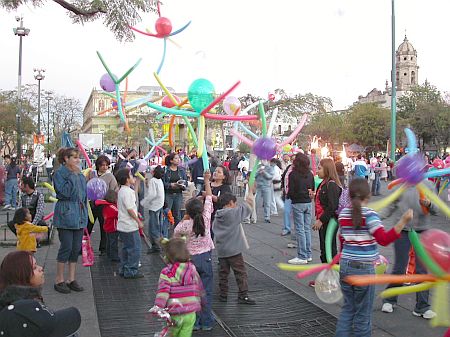 In the evenings and at the weekends an otherwise very busy city gets it really going. Mariachi musicians move through the restaurants, music sounds from all corners, open air concerts take place at the city squares, armies of flying merchants flooding the streets offering food, drink, craftwork, toys and whatever else. And the Mexicans buy enthusiastically. No child is left behind with empty hands. With their ballons, soap bubbles and all possible kinds of colourful plastic toys they turn weedend Guadalajara into a play town. They allow their colourful ballons to dance merrily above the funnel of a subterranean garage. (mi) |
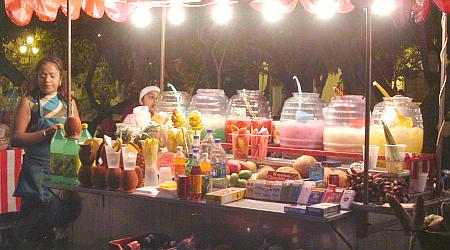 Food is no exception, as far as the Mexican's love of colours is concerned. But given the great variety of exotic fruit and plants growing in Mexico, demand is easily satisfied. Just look at this fruit juice stand in Guadalajara. And where Nature did not provide a splendour of colours, food colouring or colourful packaging will surely help. (mi) |
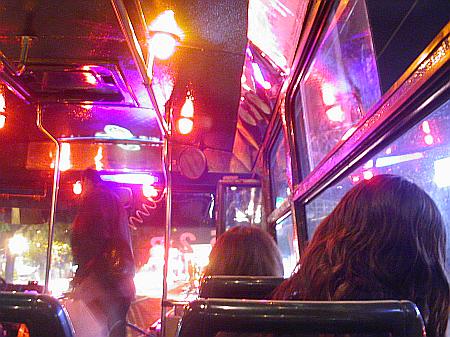 No, this is no disco, but the inside of a bus. Mexican busdrivers decorate their vehicles with a lot of love and imagination. On top of that, imagine the loud, sometimes joyous, sometimes heartwrenchingly kitschy music usually played on those buses. Going by bus is an exciting thing to do in Mexico, by the way. You always have to tell when you want to get off the vehicle (only sometimes you'll find a button to push, and it won't necessarily work). If you don't call loudly enough, the driver just keeps driving because he has just reached such a nice speed. Bus stops - where they exist at all - don't carry names. You can get on and off the bus wherever you want. (mi) |
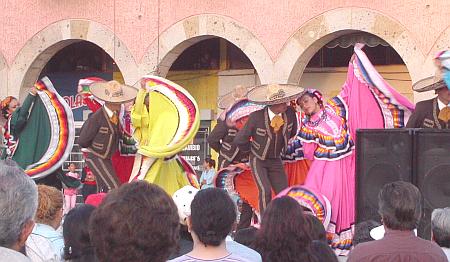 This is the traditional dress of Jalisco federal state, where Guadalajara is located. With regards both to their dresses and to their movements, women play the central role in the traditional folk dance. See more about that later at "Dances of the World" on the Art pages. (mi) |
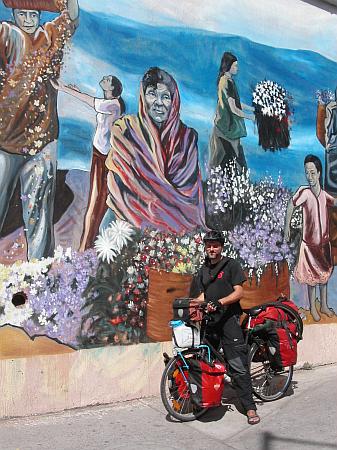 "Murales" - these are the large wall paintings typical of Mexico, which tell of the history and traditions of the country. To the German readers, Diego Riviera, husband of Frida Kahlo, may well be the best known mural panter. But it's not just the artists who paint walls eagerly. Posters and signs on plates are rarely to be found. Nearly everything is put to the walls with paint and a brush. (mi) |